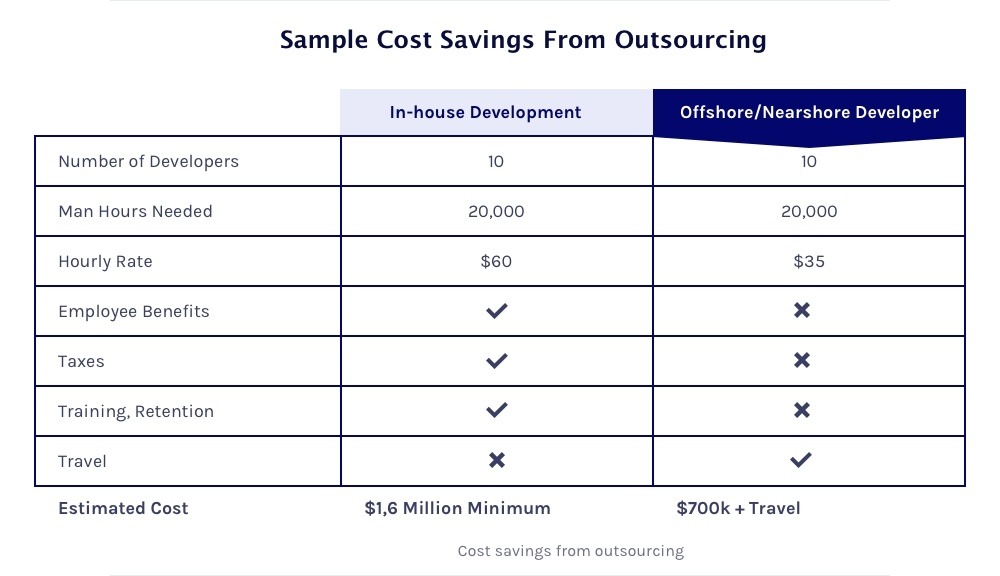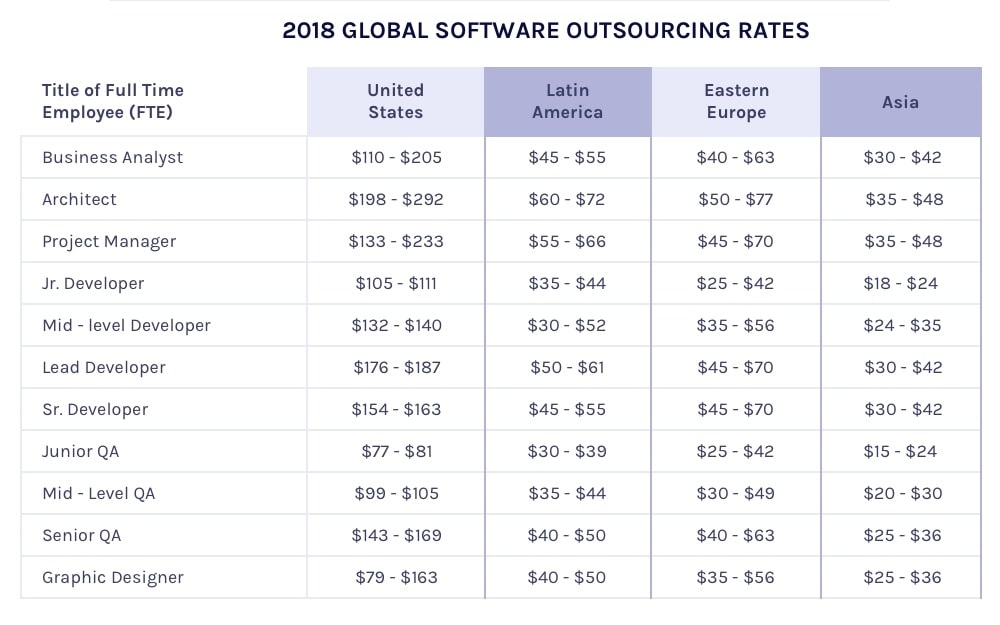In tech sectors and industries, there is a current and stable demand for qualified professionals, particularly engineers, ICT specialists, and innovative minds. According to the recent LinkedIn research Amsterdam comes out on top in the Netherlands emerging jobs market with nearly 36% of people employed in these roles located in the capital. The city is also home to nearly 45% of all open roles in emerging jobs. Amsterdam has been recognized as a tech and startup hub in multiple rankings. CoFounder magazine named it Europe’s most qualified city to attract startups leaving London due to Brexit. Given that the Netherlands has been called the new leading destination for tech, qualified professionals are still in demand.
But there is a simple solution: if you can’t find a good team in your home country, consider outsourcing as an option to extend your team and level up your business.
Why do companies outsource?
Skype, GitHub, Slack. These are just a few of the famous companies that have outsourced their development. Why would companies now worth several billion dollars outsource their development? There could be several reasons.
The first major reason is the one I mentioned above – a shortage of tech talent. Here are some of the other reasons.
Cost
The cost of software development is much lower in China or Ukraine than in the US or the Netherlands, and outsourcing might be a perfect idea if you’re striving to save money to develop and improve your business.
Nearshoring and offshoring saves on average 40% for US IT firms:

As you see, the difference is significant. Having a local office is definitely the most convenient option, but outsourcing can give you a chance to invest in your business’s future without compromising on quality.
Time
A local team requires an office, plus time and money spent on recruiting, training, and retention. In addition to the cost, it also takes a lot of time to build and support a local development team.
When you outsource development to the right company, you get a partner that starts delivering real business value within weeks, not months or years.
You also don’t need to set up the workflow in your local team from scratch, but instead get an assembled team that’s ready to start working right away.
Freedom
Here’s what one of our partners says about outsourcing development:
“Doing a workshop via Skype gives me a lot of freedom. You can be anywhere in the world and still have a development team working with you.” – Niels Jansen, Chief Technology Officer at Swishfund
Indeed, you can work from any place and communicate with your team using Skype and project management tools. And with team leads and project managers on the outsourcing company’s side, you don’t have to worry if the work is happening let alone be there in the office to monitor the team’s progress.
Focus on business tasks
With outsourcing, you can lift the burden of technical and administrative work from you and your team and focus on developing and improving your business. An experienced outsourcing company will take responsibility for everything related to development, freeing up your schedule and giving you a chance to solve your critical business tasks.
“Do what you do best and outsource the rest.” – says Peter Drucker, American management consultant. Makes sense, doesn’t it?
So you want to outsource your development
First and foremost, you should choose which type of outsourcing fits your needs best. Each outsourcing model has its perks and downsides, so your decision should depend on your business goals. Let’s figure it out!
Onshore: convenient but expensive
Onshore software development means that you outsource your development to a company in your home country.
Obviously, this type of outsourcing is the most convenient as you have an opportunity to visit the office and meet in person anytime you want. You probably speak the same language as your team and there’s no cultural barrier.
This is especially important at the very beginning of the partnership when you’re trying to explain all business-critical tasks to your outsourcing partner or when you encounter a conflict situation. It’s much easier to explain your point of view and understand the point of your colleague if you speak the same native language.
The main disadvantage of this type of outsourcing is its cost. Compared to offshore and nearshore development, onshore development is the most expensive.
According to PayScale, the average salary for a software developer in Netherlands is $51,035 per year, while in Ukraine it’s $24,652, which is quite a noticeable difference.
In the Netherlands, onshore development is the most expensive as well as the most challenging option because of the shortage of developers.
Offshore: costs less but difficult to maintain
Offshoring is outsourcing overseas or more than four time zones away.
This option is the cheapest. Accelerance, a company that assesses outsourcing companies, has created a global software outsourcing rates report:

Global software outsourcing rates
Note: Latin America includes Mexico and Central and South America. Eastern Europe includes Armenia, Belarus, the Czech Republic, Poland, Romania, Russia, and Ukraine. Asia includes Pakistan, Sri Lanka, India, Bangladesh, Vietnam, and the Philippines.
The prices may look incredibly attractive, but when you choose offshore development, you have to be ready for communication issues like delays due to time zones, cultural barriers, or lack of understanding because of the impossibility to meet in person. In the worst-case scenario, you may get a result that’s totally different from your expectations. And unfortunately, sometimes it’s easier to develop software from scratch rather than try to fix an existing app full of mistakes because of misunderstandings between a business owner and an outsourcing company.
Offshoring is the best option for those who want to сut down on development costs as much as possible, but you should put maximum effort into choosing your offshore partners, as fallout from poor communication can be fatal for your business.
Nearshore: the optimal choice
Nearshoring means outsourcing your development to countries in nearby time zones and that you can easily travel to. Nearshoring companies offer affordable prices compared to running your own development house or choosing onshore development.
At the same time, nearshore teams are easy to maintain, as on-site visits can happen more frequently and it’s easy to collaborate when you’re in the same or a nearby time zone. These benefits make nearshore development the optimal choice.
When choosing a nearshore company, you should check:
- Where the management of the company is situated and registered. Of course, it’s better if the company has an office in your country that uses the same document system and processes. This is especially important if you have a conflict with your development company. It the company has an office and is registered in your home country, at least you know who to go to and where to send your inquiries if something goes sideways.
- If the management speaks your language, that’s also a big plus.
- The level of English among developers. Good English is crucial if you want to get your project done right and on time.
HYS Enterprise is a nearshore development company for the Netherlands market. We have an office in Amsterdam, where our Dutch-speaking management is always available for consultations. Our development facilities are in Ukraine, which is only six hours from the Netherlands by plane. All HYS developers have an upper-intermediate (or higher) level of English. This helps us start easily and work with our partners as one team.
Summary
So what’s best: onshore, nearshore, offshore? This is the wrong question, as your choice should depend only on your business needs. The right question is: What’s best for my particular business?
Onshoring is a great option for businesses that simply don’t want to have their own offices (or don’t want to extend their offices). This path is perfect for those who want to save a little money and avoid unnecessary problems with office management and recruiting but still want to constantly be in touch with the development team and meet in person anytime they want. In the Netherlands, however, onshoring is the most expensive and challenging option.
Offshore development is a good idea for small companies that need to save as much money as possible with outsourcing and use this money saved to grow their businesses. But this type of outsourcing is the riskiest. To make it work, you should establish a connection with your remote team at the very beginning of a collaboration and stay on the same page till the end.
Nearshoring is for those who want to a balance between price and convenience. This option costs less than onshore or local development while being almost as convenient.
The choice is up to you!
